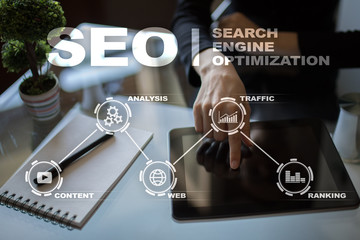Introduction
Search engine optimization is a powerful tool for helping your website show up in Google and other search engines. When people search online, they usually click on the first few results. SEO helps your site get to the top of those results. With the right strategy, you can get more visitors, grow your business, and reach more people online. In this guide, we will talk about how search engine optimization works and what you can do to improve your website.Why Search Engine Optimization is Important
Search engine optimization is very important because it helps people find your website without you paying for ads. Most people do not go past the first page of search results, so your goal should be to get on that first page. SEO also builds trust with your audience. When your site shows up at the top, people think it is more reliable. Over time, good SEO can bring you more customers, more readers, or more users, depending on your goals.How Search Engines Work
To understand search engine optimization, you need to know how search engines work. Search engines like Google use bots to visit websites and collect data. This process is called crawling. Then, the data is organized and added to a big list called an index. When someone searches for something, the search engine looks in the index and shows the best results. These results are based on many factors, such as content quality, keywords, and links.
The Role of Keywords in SEO
Keywords are the words that people type into search engines. When you use the right keywords on your website, search engines know that your page is about that topic. This helps your page show up in search results. For example, if your website is about baking cakes, using keywords like “how to bake a cake” or “easy cake recipes” helps search engines connect your content with what people are looking for.Doing Keyword Research
Before you write content, you should do keyword research. This means finding out what words people are using when they search online. You can use tools like Google Keyword Planner or Ubersuggest. Try to find keywords that have a good number of searches but are not too hard to rank for. Look for long-tail keywords too. These are longer phrases like “best chocolate cake recipe for beginners.” They are more specific and often easier to rank for.On-Page SEO Explained
On-page SEO means changing parts of your website to make it better for search engines. This includes your titles, meta descriptions, headers, images, and content. Make sure each page has a clear title with your main keyword. Use headers like H1 and H2 to organize your content. Also, use your keywords naturally in the text. Don’t overuse them, just use them where it makes sense.The Importance of Meta Tags
Meta tags are small pieces of text that tell search engines what your page is about. The most important meta tags are the meta title and meta description. Your meta title should include your main keyword and describe your content. Your meta description should give a short summary of the page and make people want to click. These tags do not always show on your page, but they do show up in search results.
Writing SEO-Friendly Content
Content is the heart of search engine optimization. When you write good content that people enjoy, search engines take notice. Your content should answer the questions your audience has. It should be easy to read and provide real value. Use your keywords, but also include related words and topics. Add images or videos if you can. Keep updating your content to make sure it stays fresh and useful.Making URLs SEO-Friendly
Your URL is the web address of your page. A clean and simple URL helps both users and search engines. Try to include your main keyword in the URL. Keep it short and avoid random numbers or symbols. For example, use www.example.com/best-cake-recipe instead of www.example.com/page1?id=234. Good URLs make it clear what the page is about.Optimizing Images for SEO
Images are great for making your site more interesting, but they can also help with SEO. Use clear and descriptive file names, like chocolate-cake.jpg instead of image1.jpg. Add alt text to each image, which tells search engines what the image shows. Alt text is also helpful for people using screen readers. Also, keep image sizes small so your pages load faster.Understanding Technical SEO
Technical SEO is all about how your website is built. A site that loads quickly and works on phones is more likely to rank higher. Make sure your website uses HTTPS for security. Fix broken links and make sure all your pages can be found by search engines. Create an XML sitemap to help search engines crawl your site. Use clean code and good hosting to keep your site fast.
Why Mobile SEO Matters
More people use phones to search the web than computers. That’s why your site needs to work well on mobile devices. Make sure your site adjusts to different screen sizes. Buttons should be easy to click, and text should be easy to read. A mobile-friendly site gives users a better experience and helps your rankings. Google uses mobile-first indexing, which means it looks at your mobile site before your desktop one.Improving Site Speed for Better SEO
Site speed is very important for search engine optimization. People leave websites that take too long to load. Search engines know this and rank slow sites lower. To make your site faster, use smaller images, remove unnecessary plugins, and use a content delivery network (CDN). Also, choose a good web hosting provider. Test your speed with tools like Google PageSpeed Insights.Internal Linking Strategy
Internal links connect one page on your site to another. This helps visitors find more of your content. It also helps search engines understand how your site is organized. Use links to guide readers to related articles or important pages. For example, link from a blog post to a product page or from one blog post to another. This keeps people on your site longer and improves SEO.The Power of Backlinks
Backlinks are links from other websites to yours. They are like votes that show your site is trustworthy and useful. The more high-quality backlinks you have, the better your site will rank. You can get backlinks by writing guest posts, sharing your content on social media, or reaching out to bloggers and journalists. Avoid spammy backlinks, as they can hurt your SEO.
Creating a Content Strategy
A good content strategy helps you stay focused and consistent. Plan your content in advance. Choose topics that your audience cares about and that match your keywords. Decide how often you will publish new content. Keep track of what works and what doesn’t. This helps you improve over time. A strong content plan makes your SEO efforts more effective.Measuring SEO Performance
To know if your SEO is working, you need to track your progress. Use tools like Google Analytics and Google Search Console. These tools show you how many people visit your site, where they come from, and what they do. Look at your rankings, traffic, and bounce rate. Use this data to make changes and improve. SEO takes time, but with patience, you will see results.Staying Updated with SEO Trends
Search engine optimization is always changing. Google updates its algorithms often. What works today might not work tomorrow. Stay updated by reading SEO blogs, watching videos, or joining SEO groups. Learn about new tools and methods. Try to test new ideas on your own site. Staying updated helps you stay ahead of the competition.Common SEO Mistakes to Avoid
There are some common SEO mistakes you should avoid. Do not stuff your pages with too many keywords. This makes your content hard to read and can hurt your rankings. Avoid using duplicate content or copying from other sites. Make sure your website is mobile-friendly and loads fast. Also, do not ignore technical SEO. Every part of your site matters.


